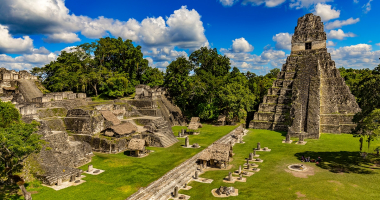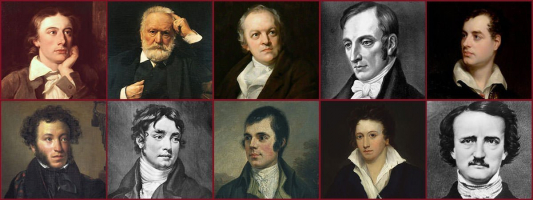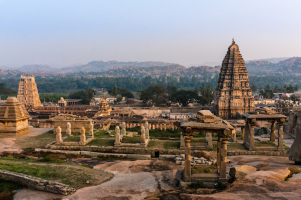Top 10 Main Teachings of The Buddha
At the heart of Buddhist philosophy lie the profound teachings of Siddhartha Gautama, commonly known as the Buddha. These teachings, encapsulated in the 10 ... read more...main teachings of the Buddha, offer invaluable insights into the nature of existence, the causes of suffering, and the path to enlightenment.
-
The Four Noble Truths is one of the main teachings of the Buddha, frequently regarded as both the bedrock of the Buddha's enlightenment and the quintessence of his teachings. These truths elucidate the essence of suffering and illuminate the pathway to its ultimate cessation.
The Truth of Suffering (Dukkha) underscores the intrinsic presence of suffering, discontentment, and restlessness. This suffering may materialize as bodily discomfort, emotional anguish, and an overarching feeling of insufficiency. This truth advocates for a candid recognition of the genuine existence of hell.
The Truth of the Origin of Suffering (Samudaya) reveals that suffering emerges from cravings, attachments, and desires. It originates from our ceaseless yearning for circumstances to diverge from their current state, fostering attachments to fleeting phenomena. This truth directs attention to the fundamental cause of suffering.
The Truth of the Cessation of Suffering (Nirodha) affirms that the end of suffering becomes attainable through relinquishing attachments and cravings. By transcending desire and passion, individuals can reach a state of liberation and emancipation from hell. This truth presents a beacon of hope and an aspirational objective to pursue.
The Path to the End of Suffering (Magga) delineates the Noble Eightfold Path as the route to the cessation of suffering. This path encompasses eight principles and practices that steer individuals toward ethical and cognitive growth.
The Four Noble Truths establish a framework for comprehending the essence of existence and provide direction in addressing suffering within one's life. These truths underscore the significance of acknowledging the origins of suffering, releasing attachments, and embarking on a journey of ethical behavior, cognitive enhancement, and wisdom acquisition, ultimately leading to liberation from suffering and enlightenment.

Photo on flickr (https://www.flickr.com/photos/lianhua/5319254494) Video by SEEKER TO SEEKER -
Commencing and concluding his teaching journey, the Buddha extensively deliberated upon the Eightfold Path. This path, a central tenet of Buddhism, is frequently regarded as a pivotal facet of the Four Noble Truths. It delineates the route toward the cessation of suffering and realizing enlightenment.
The octagonal stages can be categorized into three domains of cultivation: ethical conduct (sila), concentration (samadhi), and wisdom (prajna). Ethical conduct encompasses right speech, right action, and right livelihood. The domain of concentration involves right effort, right mindfulness, and right attention. Wisdom includes right view and intention, contributing to the growth of profound understanding.
The Noble Eightfold Path is a compass for navigating a harmonious and morally upright existence, harmonizing outward actions and inner mental maturation. It accentuates the nurturing of sagacity, virtuous conduct, and cognitive control, synergistically advancing toward the ultimate aspiration of enlightenment and emancipation from suffering.
It's worth emphasizing that the Eightfold Path isn't intended for linear adherence; its elements are intricately interwoven, mutually reinforcing one another, harmoniously guiding practitioners toward heightened insight and eventual liberation.
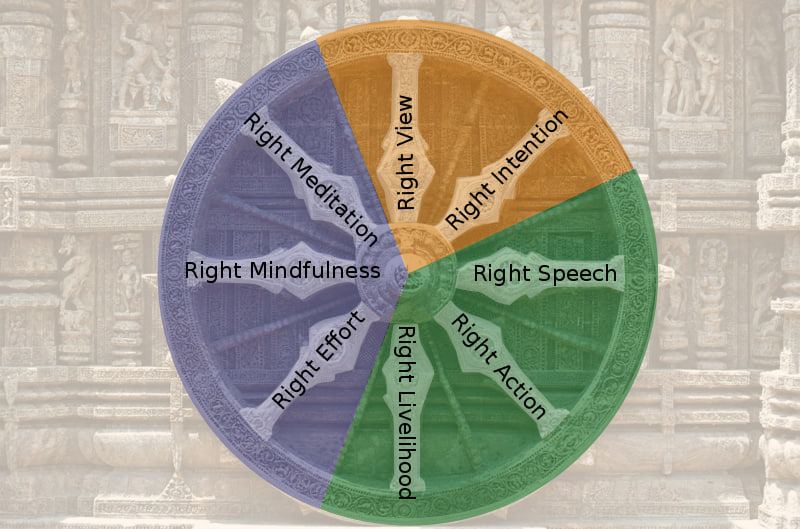
Photo on Wikimedia Commons (https://commons.wikimedia.org/wiki/File:Dharmachakra,_withprint_%28en%29.svg) Video by Study Buddhism -
The Middle Way is also one of the main teachings of The Buddha. The Middle Way, a foundational precept of Buddhism, promotes a harmonious perspective on life and spiritual pursuit, steering clear of indulgence and extreme self-denial. This pivotal insight dawned upon Siddhartha Gautama (the Buddha) amid his pursuit of enlightenment. This call for moderation has permeated Buddhist philosophy across epochs and traditions, serving as a bedrock principle.
The concept of the middle path permeates numerous facets of Buddhist philosophy, including its more abstract notions. For instance, on one occasion, when queried about the existence of the self, the Buddha chose silence as his response. He later conveyed to a disciple that an affirmative response would have inclined towards eternalism, while a negative answer could have leaned into annihilationism or nihilism. His silence, situated betwixt the two extremes, embodied the essence of the Middle Way.
During the inaugural discourse, the Buddha elucidated the middle way alongside the eightfold path, outlining its guidelines for virtuous conduct. This principle underscores the significance of steering clear of the unrestrained chase of sensory gratification and the rigid self-mortification of asceticism. Instead, the Middle Way advocates for discovering a balanced route that recognizes and surpasses the yearnings and aversions of the mind.
The Middle Way accentuates that true wisdom and liberation arise through comprehending and surpassing the dichotomies and attachments that give rise to suffering. It encapsulates a comprehensive outlook on life, advocating a harmonious and attentive approach to living, contemplating, and pursuing the ultimate truth.
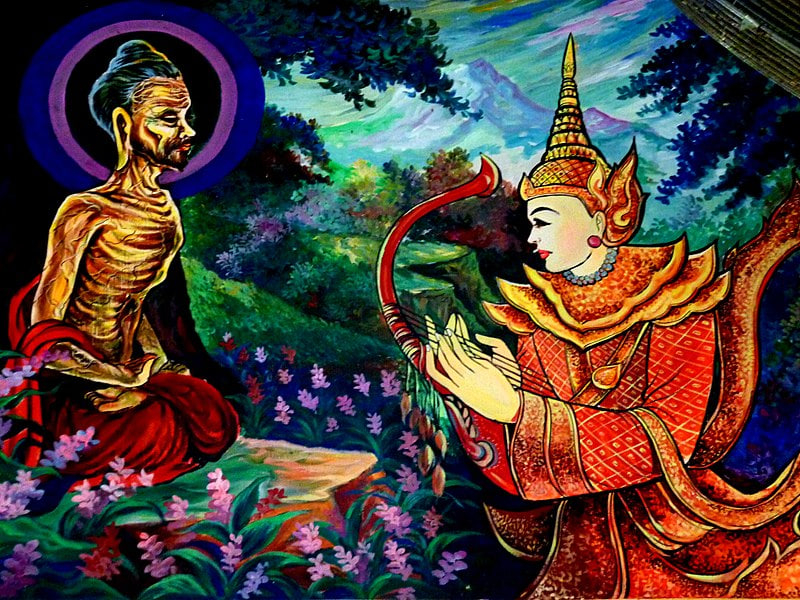
Photo on Wikimedia Commons (https://commons.wikimedia.org/wiki/File:035_The_Bodhisatta_Learns_the_Middle_Way_%289014442088%29.jpg) Video by Nichiren Buddhism -
The Buddha's teachings encompass the understanding that all phenomena, surrounding thoughts, emotions, and experiences, bear three fundamental traits known as the Three Marks of Existence: impermanence (anicca), suffering (dukkha), non-Self (anatta). Rooted in Buddhist teachings, the Three Marks of Existence shine a light on the innate essence of all phenomena and guide the journey toward liberation from suffering.
Everything changes, the Buddha taught. Impermanence underscores existence's fleeting and constantly shifting character, where no element remains unchanging; all is subject to ceaseless transformation. Grasping the concept of impermanence empowers individuals to release attachments and cravings, paving the way for liberation from suffering.
Dukkha stands as one of the frequently misconstrued concepts in Buddhism. When the Buddha proclaimed that life is dukkha, he did not intend to convey perpetual unhappiness and disappointment. Instead, dukkha points to the inherently unsatisfactory and, at times, distressing facets of existence. It encompasses physical and mental suffering and the inherent sense of discontentment woven into worldly encounters. Acknowledging dukkha catalyzes the quest for liberation and cultivates a more profound grasp of reality.
Anatta proves to be an even more intricate concept to fathom. The Buddha imparted that within our bodies, there exists no enduring, unvarying self. Anatta reveals the nonexistence of an everlasting, fixed self or soul, thereby shaking the foundation of an autonomous and lasting identity. This perspective challenges conventional notions, highlighting the interconnectedness and interdependence of all phenomena. By embracing this insight, one can unravel attachments and cultivate a deeper understanding of the essence of reality.
The Three Marks of Existence provide a profound framework for perceiving the nature of life and the means to transcend suffering. They guide practitioners toward liberation by encouraging a shift in perspective and deepening insight into the fundamental truths of existence.
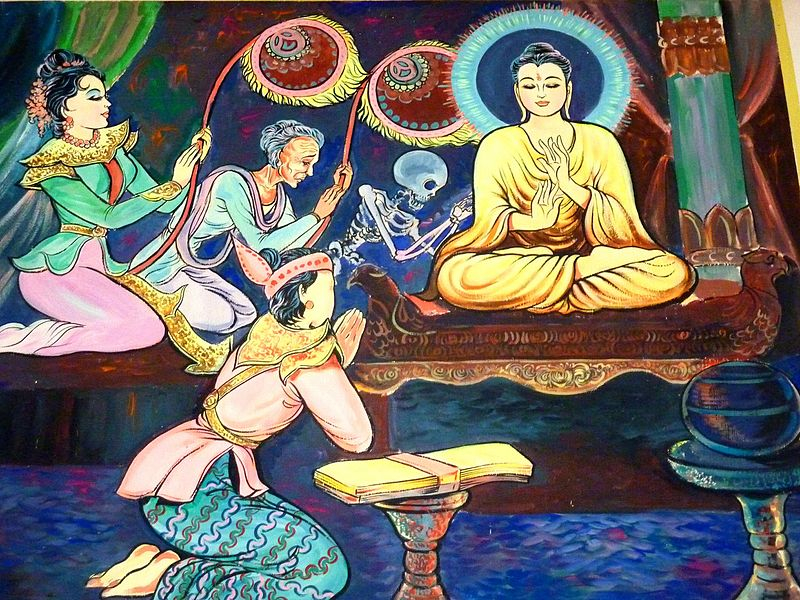
Photo on Wikimedia Commons (https://commons.wikimedia.org/wiki/File:056_Teaching_Impermanence_%289014223736%29.jpg) Video by Bhumika Chotaliya -
In his initial teachings, the Buddha highlighted the existence of the Three Poisons as the source of many challenges in our lives and the world. These three poisons, greed, hatred, and delusion, are fundamental principles within Buddhist doctrine. They stand as the root causes of suffering, obstructing the path toward spiritual development and enlightenment.
Greed (Raga) encompasses an excessive fixation on material possessions, sensory pleasures, and desires, giving rise to attachment and insatiable cravings. This inclination toward accumulation leads to discontentment and contributes to an unending cycle of suffering by fostering a ravenous yearning for more.
Hatred (Dosa) denotes aversion, anger, ill-will, and any manifestation of antagonism or negativity directed at oneself or others. It spawns discord, disharmony, and emotional upheaval, adding to the burden of suffering and prolonging detrimental cycles.
Delusion (Moha) symbolizes ignorance or misconstruing the genuine essence of reality. It encompasses misperception, misinterpretation, and adherence to skewed perspectives. Delusion clouds the comprehension of impermanence, interdependence, and the origins of suffering.
Regarded as the fundamental sources of suffering, the Three Poisons entangle individuals within the cycle of birth, death, and rebirth. The journey toward liberation and enlightenment entails acknowledging, facing, and transcending these poisons through ethical behavior, mindfulness, and wisdom. By eradicating greed, hatred, and delusion, practitioners can attain a state of clarity, compassion, and liberation from suffering.
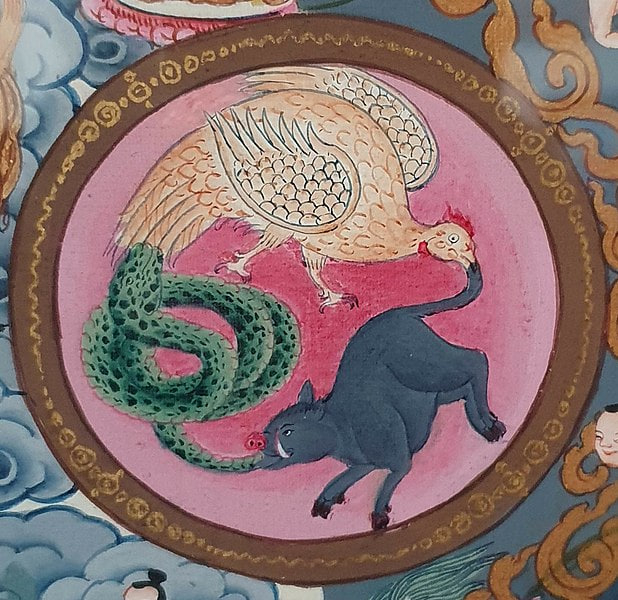
Photo on Wikimedia Commons (https://commons.wikimedia.org/wiki/File:Three_poisons_at_hub_of_wheel_%28cropped%29.jpg) Video by Himalayan Art Resources, Inc. -
Another major teaching of the Buddha is about Karma. Karma is pivotal in Buddhism, centering on the principle of cause and effect. It encompasses the understanding that deliberate actions, spanning physical, verbal, or mental domains, yield outcomes that mold current and forthcoming life experiences. Karma is based on the principle that every positive or negative action generates corresponding results.
The Buddha imparted that karmic accumulation extends from past lives and current existence, yet karma remains subject to change. Each moment presents a chance to engage in constructive behavior to cultivate thoughts, words, and actions that steer us clear of the entanglement and misconception perpetuating suffering. Practitioners can shape karma, paving the path for a more promising future.
Each practitioner has the responsibility for their actions and the ensuing karmic outcomes. No external deity or force dictates one's fate; instead, the culmination of choices and intentions defines one's path.
Buddhism underscores the significance of comprehending and adeptly navigating karma, guiding individuals towards a life imbued with mindfulness and compassion, and fostering personal evolution and spiritual advancement. Practitioners strive to draw nearer to liberation and enlightenment by nurturing positive and mitigating negative karma.

Photo on flickr (https://www.flickr.com/photos/waywuwei/279464565) Video by Words of Wisdom -
One of the ancient methods of demonstrating faith in Buddhism involves seeking refuge in the Three Jewels. These jewels encompass the Buddha (the enlightened guide), the dharma (the teachings), and the sangha (the community of fellow practitioners). For numerous adherents, taking refuge marks an initial stride in embracing a Buddhist identity, along with adhering to the precepts—a set of ethical guidelines for living a virtuous life.
The initial jewel pertains to Siddhartha Gautama, the Buddha, who attained enlightenment and unveiled the pathway to liberation from suffering. Seeking refuge in the Buddha encompasses entrusting in his teachings and drawing guidance from his enlightened model.
The second jewel envelops the teachings of the Buddha, encompassing the Four Noble Truths, the Noble Eightfold Path, and the comprehensive repository of wisdom and guidance that steers individuals towards comprehending reality and achieving liberation.
The third jewel embodies the Sangha, comprising monks, nuns, and lay practitioners who uphold and nurture the teachings. Seeking refuge in the Sangha entails seeking guidance, inspiration, and reciprocal support from fellow travelers on the spiritual journey.
By embracing the Three Jewels, individuals harmonize with the enlightened wisdom of the Buddha, the guidance of his teachings, and the supportive community of fellow seekers. This practice acts as a guiding compass for ethical conduct, spiritual advancement, and the journey toward attaining enlightenment and liberation from suffering.

Photo on Wikimedia Commons (https://commons.wikimedia.org/wiki/File:1_Trois_Joyaux-Three_Jewels-Tres_Joyas.jpg) Video by Buddhism For Beginners -
Nirvana occupies a profound role in Buddhist teachings, signifying the paramount objective of spiritual realization and emancipation from the cycle of suffering. It is frequently portrayed as a state characterized by consummate serenity, tranquility, and enlightenment. The Buddha attained Nirvana on the night of his culture, liberating himself entirely from the Three Poisons. His subsequent teachings were all directed toward assisting others in achieving that identical freedom.
Nirvana encompasses the dissolution of the ego's illusory sense of self and the relinquishment of desires that ensnare individuals in worldly existence. It signifies liberation from the repetitive cycle of attachment and craving.
Nirvana symbolizes the transcendence of dichotomies and dualities, spanning realms like pleasure and pain, life and death, and self and others. It signifies a state that exists beyond the confines of conventional conceptualization.
Nirvana often intertwines with profound mindfulness and heightened awareness. It encompasses comprehending the genuine nature of reality and the interconnectedness of all phenomena. Nirvana isn't confined to philosophical contemplation; it's a firsthand experience attainable through dedicated practice, meditation, virtuous living, and the nurturing of wisdom.
Pursuing Nirvana is a fundamental aspiration for Buddhists, directing their endeavors toward liberation from the cycle of suffering and attaining supreme enlightenment. It epitomizes the culmination of the path laid out by the Buddha, encompassing the Four Noble Truths, the Noble Eightfold Path, and a multitude of teachings designed to guide individuals toward a state of enduring serenity and liberation.
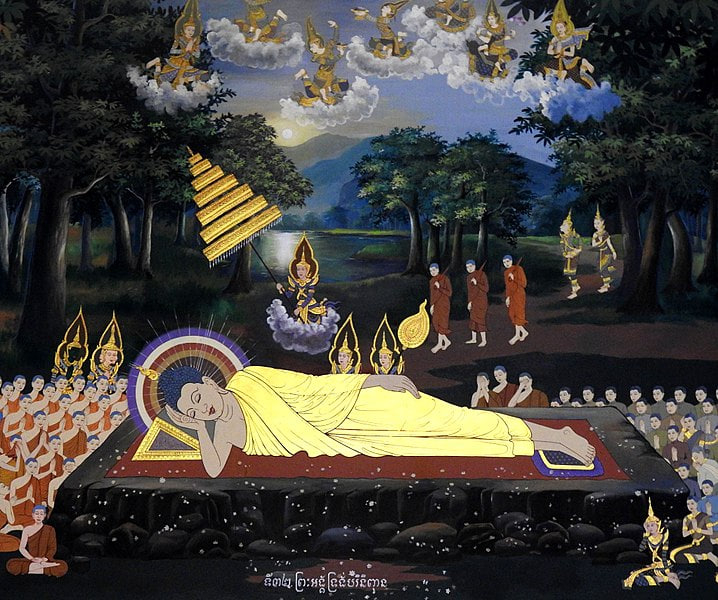
Photo on Wikimedia Commons (https://commons.wikimedia.org/wiki/File:Gautama_Buddha_gains_nirvana.jpg) Video by Dhamma Source -
Dharma occupies a pivotal role as a primary cornerstone in Buddhism, encompassing an extensive array of profound concepts and guiding principles. It includes the entirety of the Buddha's teachings, which provide direction for leading a life that is ethical, purposeful, and imbued with enlightenment.
Dharma delineates guidelines for ethical conduct and virtuous existence, emphasizing values like compassion, non-harm, honesty, and generosity. It establishes a structured framework for cultivating harmonious relationships with oneself and others.
Dharma includes moral precepts that steer practitioners towards making skillful decisions and abstaining from harmful actions. These precepts foster mindfulness and cultivate a purposeful intention in the fabric of daily life. Further, Dharma is not merely descriptive but prescriptive, the ethical conduct set out in the eightfold path that leads to an awakened life.
Engaging in the study and application of Dharma forms a fundamental cornerstone of the Buddhist tradition, leading individuals toward a life characterized by wisdom, compassion, and liberation from suffering. It fosters a deep comprehension of the essence of reality and equips individuals with pragmatic tools for promoting personal transformation and nurturing spiritual evolution.

Photo on flickr (https://www.flickr.com/photos/archer10/2611076664) Video by Embodied Philosophy -
Buddhanature is significant in Buddhist teachings, accentuating the intrinsic potential for enlightenment inherent in every sentient being. It illuminates the facets of regular individuals that bear resemblance to those of a Buddha. This teaching underscores the conviction that every individual inherently possesses the qualities essential for attaining Buddhahood, irrespective of their circumstances.
Buddhanature asserts the presence of vital attributes within every being necessary for attaining enlightenment. It suggests that the potential for awakening resides within, awaiting realization through dedicated spiritual practice.
Buddhanature emphasizes parity among all individuals, indicating that the potential for enlightenment transcends external influences like social status, background, or past actions. This principle harmonizes with the ultimate aspiration of Buddhism, to awaken to one's genuine essence and achieve enlightenment, commonly known as Buddhahood.
Buddhanature fosters the nurturing of virtuous attributes and the dismantling of impediments that obstruct the recognition of one's authentic essence. It advocates that all sentient beings possess the inherent capacity to liberate themselves from suffering and achieve a state of liberation.
Buddhanature stands as a poignant testament to the intrinsic dignity and latent potential residing within every living being. It inspires practitioners to embark on a profound transformation journey, guiding them toward self-discovery, awakening, and the revelation of their genuine essence.
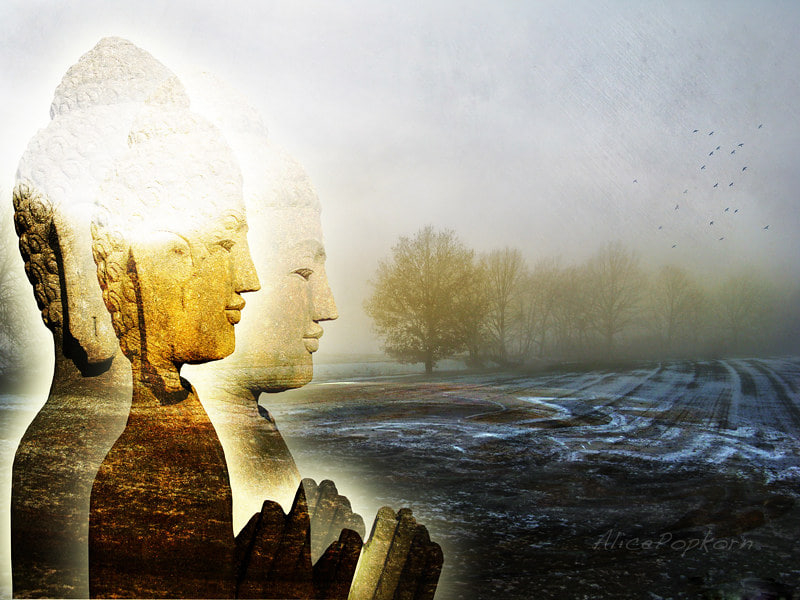
Photo on flickr (https://www.flickr.com/photos/alicepopkorn/5509427352) 
Photo on Wikimedia Commons (https://commons.wikimedia.org/wiki/File:Buda_dormindo.jpg)























